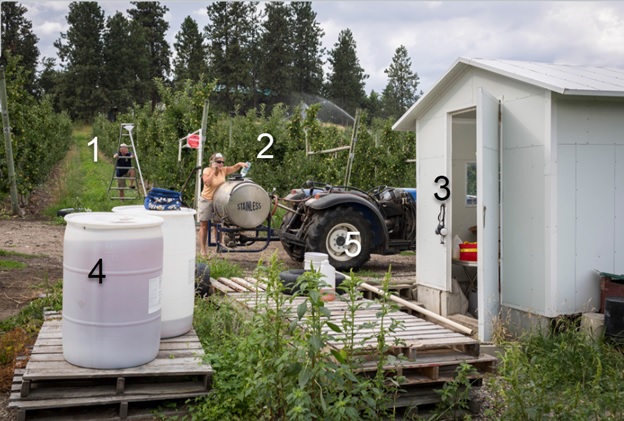Picture This: Orchard Workers are Ripe for an Injury
Here’s a great staged image from WorkSafeBC that shows a bushel of unsafe acts and conditions that could easily lead to a near miss, injury, or illness. While this shows orchard workers, the hazards are universal and understanding what’s wrong here can help keep you safe wherever you are. Let’s look at some of the hazards.
1. The orchard ladder is set up facing downhill – not uphill. The ladder’s tripod is also set at an unsafe angle and the ladder is set too far from the trees. These conditions mean the ladder is not going to be stable, the worker is forced to act unsafely because of the ladder’s position. He will have to pick from an awkward position, over-reach and ultimately be off-balance on the ladder. The chances of falling are high – will he be lucky and end up with only a few scrapes?
a. Always set up ladders on an even, level base. Orchard ladders specifically must have the tripod pole positioned uphill if it’s on sloped ground.
b. Orchard ladders must be firmly in the ground to keep it from collapsing, slipping, moving, or falling. When placing extension and other non-self-supporting ladders, remember the four-to-one rule: for every four feet of height you climb, move the base one foot away from the wall.
2. The worker pouring chemicals into the “Stainless” tank is not wearing PPE, she’s using the wrong container to add chemicals to the tank, and she shouldn’t be on her cell phone.
a. When working with chemicals correct PPE is a must. It’s likely the worker in this photo should be wearing a respirator and an impervious chemical suit, (not t-shirt, shorts, and sandals) and she should absolutely be wearing goggles, a face shield, and closed-toed shoes.
b. She should only use properly labeled and approved containers to transfer chemicals. Not what appears to be a water bottle – or any other random bottle she finds. It’s far to easy for someone to take a drink from an improperly marked bottled and end up sick, injured, or dead.
c. Lastly, she shouldn’t be talking on her cellphone. Cross-contamination is possible, and she could unwittingly expose herself and her family to harmful chemicals.
3. The white storage shed is being used to store chemicals, but it is not marked, there is no visible ventilation, and items such as the respirator, first aid kit, and food shouldn’t be anywhere near it.
4. You might have also noticed the lunch bag hanging out on the chemical barrels.
a. Chemicals and food and drinks don’t mix! Don’t store or place any food or drink on or near chemical storage areas or anywhere chemicals are used or stored.
b. Wash your hands after working with chemicals and before eating or drinking.
5. A few last unsafe conditions in this photo include the ROPS (roll over protection system) on the tractor should be up and in use. The pole in front the of the storage shed door is an obvious tripping hazard. So too, are the tall weeds and the pail on the steps.
